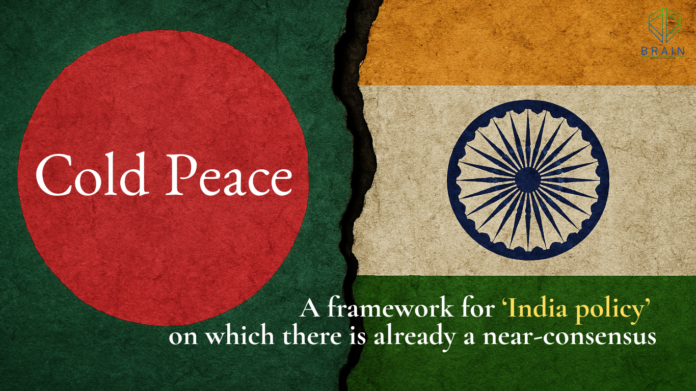- Jyoti Rahman
A framework for ‘India policy’ on which there is already a near-consensus.
Sheikh Hasina visited India in January 2010, generating a huge hype in Dhaka. I couldn’t find anything at the official communique signed by the prime ministers of the two countries to justify the hype. My friend Zafar Sobhan said that not everything can be gleaned from the official statements. He went on to note that no text would capture the sentiment that had changed between the policymakers of the two countries.
The subsequent decade and half of Indian policy towards Bangladesh — first the unreserved support of Hasina regime’s growing despotism and now the refusal to engage with the government of Professor Yunus in good faith — shows that Zafar was right. There was nothing in any official statement that would suggest this was coming. But clearly India had decided to put all its egg on Hasina’s basket, and her Jan 2010 pilgrimage to New Delhi was a much bigger deal than any communique would portray.
Of course, India’s policy has disastrously backfired. Not only did Hasina have to flee Bangladesh, with her very presence in India creating a major foreign policy headache for New Delhi, India is now utterly without any friend in Bangladesh. People who had once upon a time considered greater Indo-Bangla economic and strategic collaboration to be mutually beneficial — for example, Mahfuz Anam or Debapriya Bhattacharya — now routinely, and accurately, blame India for its support of the Hasina regime.
Indeed, in my adult life, I have never seen a stronger consensus among Dhaka’s establishment than what is there currently on India — that New Delhi is no friend of Bangladesh.
Against that backdrop, let me propose a policy framework to guide our approach in the years to come: Cold Peace, by which we make it very clear to the Indian establishment that while we maintain a formal working relationship between the two countries (Peace), there is no appetite to pursue any deeper strategic or economic engagement until there is a fundamental ‘regime change’ in Indian establishment (Cold). In practice, this means various official level meetings of joint groups and working parties, perhaps even foreign minister level meetings, but no major bilateral summits or new agreements worthy of any hype.
To put things concretely, a Cold Peace policy towards India would mean using the most formal channel possible to:
- protest every instance of border killing and pursue all mechanisms possible to end the use of lethal force by Indian BSF;
- seek the extradition of Sheikh Hasina, even if it is arguably futile;
- seek a better distribution of water, noting that this would be futile and therefore pursuing other options;
- renegotiate various one-sided agreements (such as that with Adani);
- inform Indians that as long as they respect Bangladesh’s political stability, we will not allow anti-Indian militancy and insurgency.
Before unpacking the Cold Peace framework by considering various issues between the two countries, let me note a couple of books.
Ramachandra Guha is one of my favourite chroniclers of India. And his India after Gandhi is one of the best books on modern India. The book also reveals something quite interesting about which of their neighbours the Indian punditry care about. Bangladesh is mentioned in the book in 15 pages, out of nearly 800, with four being on 1971. Meanwhile, there are 200 entries on Pakistan in its index. Bhutto appears in eight pages, Ziaul Huq in one. Mujib makes four appearances, none of his successors get a mention. Or consider David Malone’s Does the elephant dance? Contemporary Indian foreign policy — a 400-page book where Bangladesh appears in 20 or so pages, slightly above Afghanistan.
These show how little Bangladesh mattered to the Indian establishment. These also explain why they were caught completely off guard by the Long July. Arguably, the Indian establishment sees Bangladesh through only lens: security.
In the 2000s, Indian foreign and national security establishment came to believe that Bangladesh was either a willing accomplice with, or a passive safe haven to, forces hostile to India’s territorial integrity. After 2009, the Hasina regime dismantled any militant infrastructure.
What should we do now?
Of course, security concerns can cut both ways. India fuelled two insurgencies against the Bangladeshi state in the 1970s. The Shanti Bahini activities in the Chittagong Hills lingered because of genuine grievances, but Kader Siddiqi’s ‘resistance’ after 1975 floundered. Unless India were to play funny games again, does Bangladesh have anything to gain by fostering militancy and extremism when these elements have been nothing but trouble for us?
That is, as far as security is concerned, a Cold Peace policy would be one where India is told that we won’t allow militancy as long as India does not foster anti-Bangladesh activities.
Of course, the biggest source of anti-Bangladesh activities of our time is Sheikh Hasina herself. While we pursue a legal process to try her, it is quite likely that she will spend the rest of her days in a secluded bungalow in India. But what about the hundreds, perhaps thousands, of Awami League cadres living in India?
Well, what about them?
In a sense, of course, they are India’s problem. After all, many (if not most) of these people are criminals whose very presence would be a headache to the local law enforcement agencies. If some of them were to return to Bangladesh, that would become our domestic political problem. As long as Indian establishment does not try a Kaderia Bahini style misadventure, letting things be would be a perfectly fine option for Bangladesh.
Will a policy of Cold Peace get us our fair share of water? Probably not.
Even an obsequious and submissive Hasina couldn’t get a deal on Teesta. India is a federation, and Mamata Banerjee is a key political player for whom Teesta is a major card. The chances of the interim government or the next elected government striking a deal on Teesta is close to zero.
More generally, India is upstream, and it has been unilaterally diverting water away from us. We need to pursue a multi-pronged approach on water. We need to try as much as possible on multilateral front, utilising all treaties and conventions as we can, noting that the rules-based multilateralism is itself on the wane. We need to try to engage with China, which is even further upstream. And we need improve our water management policies against a baseline of Indian non-cooperation.
What about the economy?
Of course, we should seek to renegotiate every single economic agreement or memorandum of understanding signed by the Hasina regime because they were all likely to have been one-sided and against Bangladesh’s interest.
But beyond that, what about the economy?
Two decades ago, liberal economists and the intelligentsia in Bangladesh used to talk about the benefits of economic integration with India. The numbers didn’t make sense to me then, and the experience of the past 15 years suggests there isn’t much to be gained by futile attempts at better trade and investment deals. Bangladesh’s main imports from India are agricultural products — cotton and foodstuff. Plus, there is medical and educational tourism. Diversification of both would be a good idea in and of itself. Improving domestic healthcare, or developing our tourism, are important policy objectives.
More generally, Bangladesh should pursue active international trade and foreign investment policies with many countries. To the extent that we have limited bureaucratic capacity, deprioritising India is perfectly appropriate.
Finally, there is the issue of border killing. Every single such death is a gross reminder of India’s criminal negligence, and the Indian diplomats and security officials should be reminded of that at every instance.
While the Bangladesh government pursues a Cold Peace policy, private citizens — writers, artists, think tanks, activists — should do whatever is consistent with their own politics. Those who base their politics on hardline anti-Indianism might find it hard to rail against a government that pursues Cold Peace policy. For the liberals and progressives on both sides of the border, better communication and engagement can only be a good thing. After all, an end of the Hindutva regime is ultimately crucial for pluralism and democracy in, and indeed the integrity of, India itself.
- I coined the term Cold Peace in 2011 in a now-defunct blog.
Original Source: Mukti

